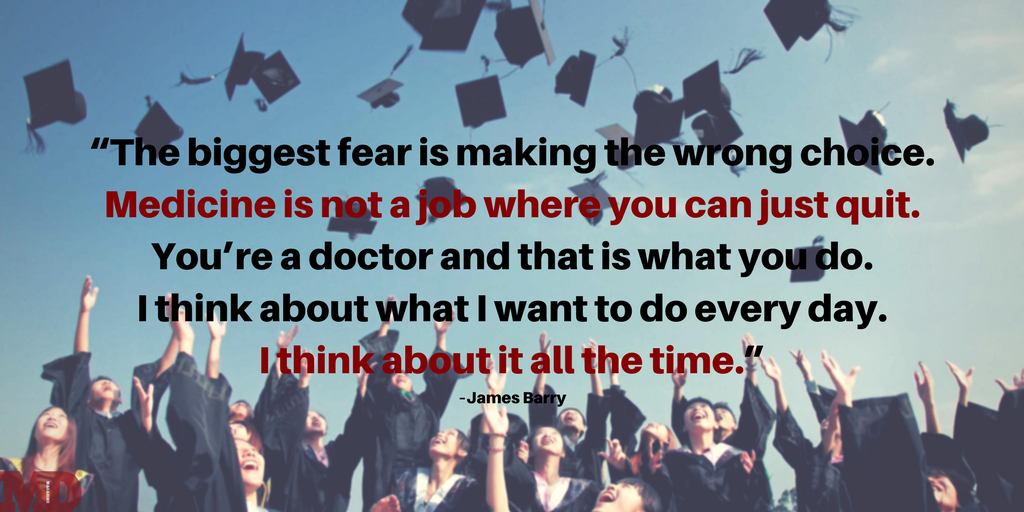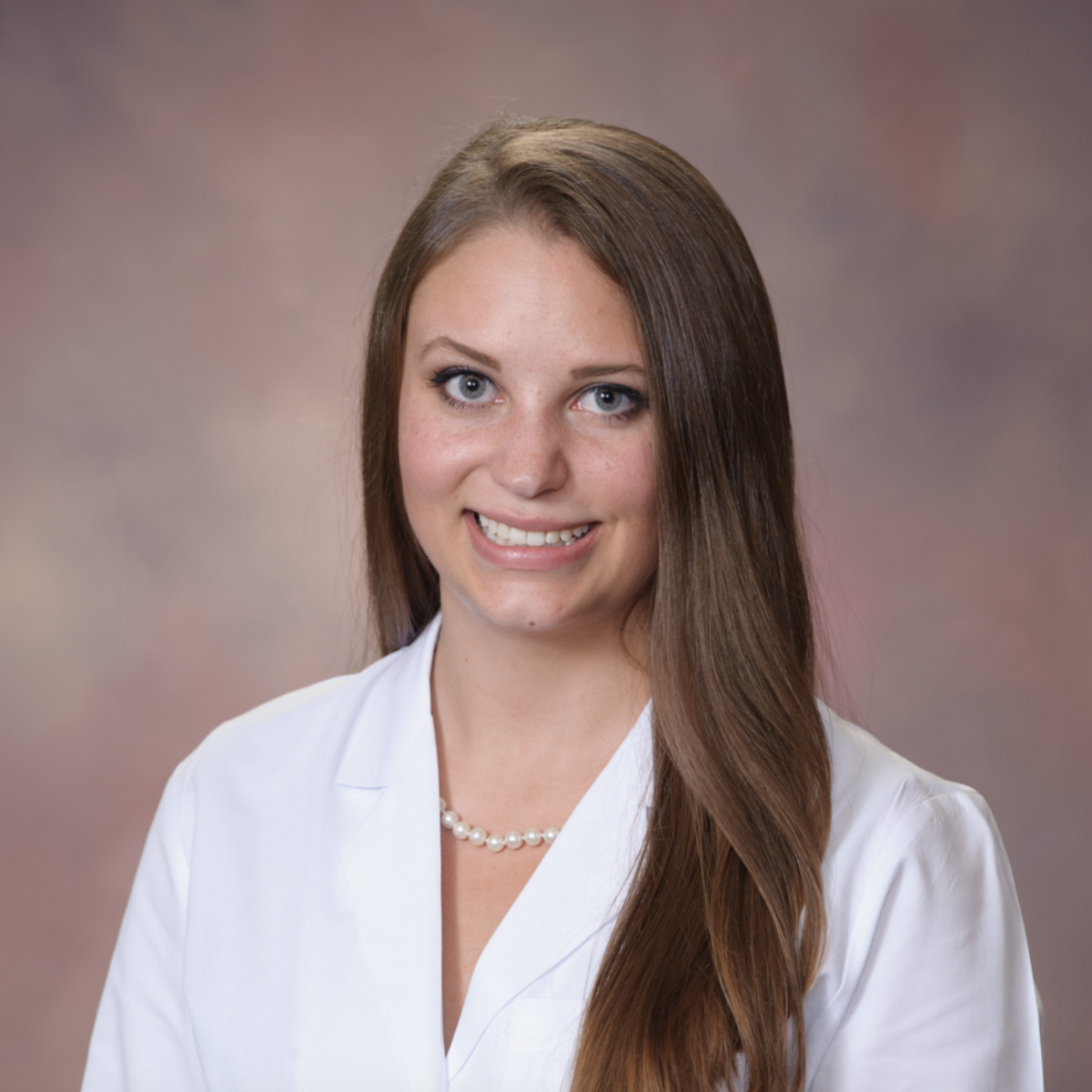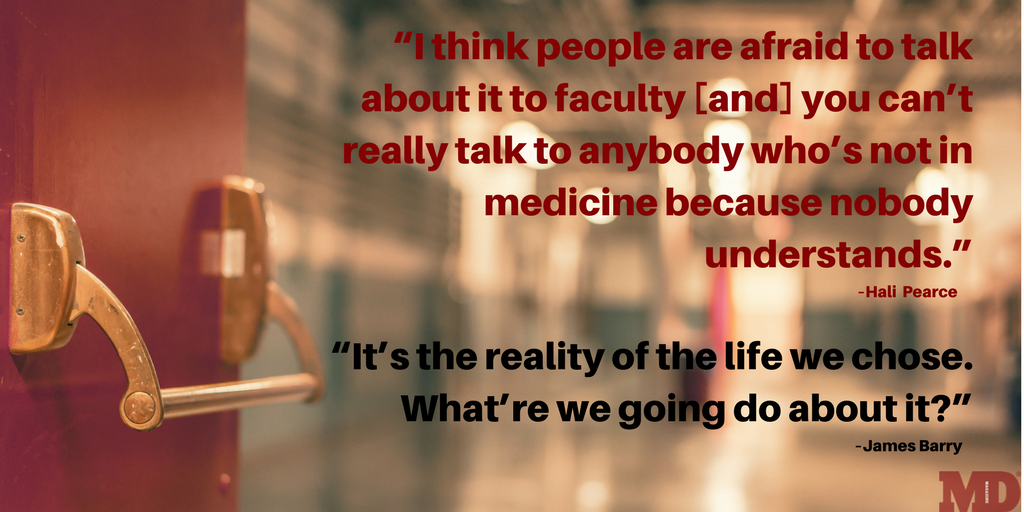Article
To Heal and Be Happy: Choosing a Specialty and Surviving in Medical School
Author(s):
For medical school students, choosing a specialty is a decision that carries a lifetime's worth of weight. What factors go into that choice?

John entered medical school wide-eyed and eager for what lay ahead. Although he hadn’t attended his first lecture, he could already envision himself emerging from school as a steward of public health, driven by a meaningful purpose and supported by a strong financial foundation. One day, he’d tow the family line for his physician father.
He spent the first half of medical school studying the human body and the seemingly infinite approaches to helping it heal. Before long, it’d be time to start studying for his board certification. Then, by his third year, John would need to make a choice about which area of medicine he would spend the rest of his life practicing.
“It’s hard to choose a specialty from your first 2 years when you’re just in a classroom,” he told MD Magazine. “You take these modules—cardiology, gastroenterology, etcetera—and people gain interest, but you don’t really see the clinical side until you’re doing it.”
Who to Treat and When?

Hali Pearce
Once John began participating in rotations, gaining real-life clinical experience, and working alongside physicians who had been through the difficult decision-making process, the picture became clearer. A mix of passion, experience, and practicality helped him arrive at a decision that’d define the decades ahead—John would become an OB/GYN.“Once I sat down and thought about it, I thought OB/GYN was great for me,” John, a fourth-year medical student said. “A big part of choosing is deciding the patient population you want to work with.”
Understanding the importance of patient populations took time for Hali Pearce, a third-year medical student at the Alabama College of Osteopathic Medicine. Over time, she learned that your work is defined by the type of patients you treat, she said. That’s why she’s leaning towards urology, a surgical subspecialty that’s extremely competitive, but comes with a lower stress-level than many other surgical specialties.
Urologists are “known as the happiest surgeons. You cut a couple kidney tumors out and you call it a day,” she said. “There’s really not too many, ‘Oh my god, my patient is dying right now!’ type of situations, even though I like those situations. They’re cool in your 20s and 30s, but when you’re 50 or 60 years old, you don’t want to be doing that kind of thing.”
On the other hand, Pearce has plenty of peers who dream of a life in the emergency department (ED). They’re drawn in by the intense practice of treating trauma patients in life-or-death situations—stabbings, car accidents, gunshot wounds. But every medical student should try to avoid romanticizing their specialty, emergency physicians included.
“Treating emergency situations in the ER is cool, yes, but 90% of what you’ll see in there are people with a cold who don’t have insurance,” Pearce said. “You’ve got to love treating the person with a cold as much as the person with 6 gunshot wounds, and that’s why the ED burnout rate is so high. They get into it for the trauma stuff, and that’s not really what the ED always is.”
James Barry, a second-year student at Rutgers Robert Wood Johnson Medical School, in Piscataway, New Jersey, is focused on entering a specialty that offers a healthy dose of clinical variability. It’s a big part of the reason why he got into medicine—to avoid the rut of a standard desk job. He’s thinking about entering sports medicine or pediatrics—but again, “until you get the clinical experience it’s hard to decide,” he said.
A Little Bit of Everything
“It’s a mix of both patient [populations] and [clinical] scenarios,” he told MD Magazine. “There are fields where you’ll only work with certain populations, but generally, everywhere—especially in a hospital—the population is older. As far as [clinical] situations, that’s more important to me. I don’t want to deal with the same thing every day.”Many medical schools, including both Pearce’s and Barry’s, try to stoke student interest in primary care, and for good reason. The United States is on the cusp of a physician shortage, and its most obvious victim is the primary care practitioner (PCP). As the US population ages, chronic diseases run rampant, expectations grow, and specialists take home the lion’s share of the pay, primary care has become less attractive to medical students.
“I think that for [PCPs, the workload] was kind of a daunting thing. You do really need to know a little bit about a lot of things,” John said. “But the other side of it, is if you work in an area with a plethora of physicians to refer to, it’s not as daunting. You can call colleagues and get advice.”
In the US, primary care is arguably one of the most demanding practices. Currently, 15% of the population is aged 65 years or older, and the Population Reference Bureau projects that by 2060, that demographic will more than double to almost 100 million people—roughly 25% of all Americans.1 PCPs usually bear the brunt of treating this older population, who often present with multiple chronic conditions that don’t improve.
“Treating chronic disease is hard—it’s not all rainbow and butterflies,” John said. “Those who do it are wonderful, and my hat is off to them. They deal with people who aren’t compliant and are hard to treat. It’s daunting at first if you don’t know what they do on a day-to-day basis.”
Still, there are some who step up to the challenge. Barry admitted that he didn’t know a single student who came into school wanting to go into primary care, though some choose the route after careful reflection. Pearce’s school, meanwhile, has a high rate of primary care graduates, which she attributes to the school’s efforts to support the local patient population in an area with few available PCPs. Even with that effort, supply isn’t meeting demand.
If patient population and situational considerations really are top factors in deciding a specialty, it’s no wonder primary care is becoming less attractive to medical students. Medicine is trending toward personalized care, and treating patients who present with multiple comorbidities can intimidate a new physician. “It scared me,” John said.
John’s first primary care rotation immediately shattered his expectations of what the practice would be like. It took place in a small rural town in the southern US. There was only one doctor, and she was seeing what felt like a municipality’s worth of patients each day. John watched as she wrote prescriptions for vital medications, only to find out her patients’ insurance wouldn’t cover the cost.
The Reality of the Choice

“Day in and day out you’re trying to do the best you can, and no one gets better,” he said. “You go through all this training and want to make a difference…but it’s hard to do the work and feel like you haven’t made the progress.”For physicians and medical students, stress and burnout are always looming. During rotations, Barry said he’d hear horror stories from docs, who told him to avoid their specialties at all cost because of the ridiculous demands. John had a student in his class drop out because of burnout the week before he spoke with MD Magazine.
“Medical school is hard—10% of your class fails after the first semester,” Pearce said. “I think people are afraid to talk about it to faculty [and] you can’t really talk to anybody who’s not in medicine because nobody understands.”
Pearce preaches proactivity to combat burnout among her peers. Once a month, her and 6 of her friends gather for a night to de-stress, detox, and dish about what they’re going through. Barry does the same. He said that most of the conversations he has with his peers are about how wiped out they are.
“It’s the reality of the life we chose. What’re we going do about it?” he said. “The only way to fix burnout is by effectively staffing hospitals, but the aging population exacerbates that. I don’t see a feasible answer, other than better preventative medicine and a better healthcare system.”
Solutions for employee well-being aren’t always available at hospitals but are more common in medical schools. Still, Barry admitted that the wellness services at Rutgers Robert Wood Johnson Medical School usually go unused. “For lack of better phrasing, we don’t have time for that kind of stuff,” he said.
Pearce, though, has utilized the services her school offers. There’s a psychologist on hand that students can visit up to 3 times without a fee. “In my second year, I went through a really hard time. I had really bad stress and anxiety,” Pearce said. The program helped her manage.
John, Pearce, and Barry all said that burnout influences specialty decisions for most medical students. Barry said he has considered aiming for a less stressful specialty, but said he prefers higher-stress environments because he counts on stress for validation.
Planning the Long-Term
“There are plenty of people who couldn’t handle the stress and emotion [of medical school], and some people drop out. No fault to them. The environment is very stressful, and for good reason—you need competent people,” he said. “I thank god I [matched], but I worked very hard for long hours to do it. To me it’s worth it.”As with any occupation, the lifestyle that accompanies the work is just as important as the work itself. Doctors are known for the long hours they work, but the basic desires that human beings crave—a chance to have a family, friends, and to see the world—are not lost on those who undertake the practice of healing.
While John, Pearce, and Barry all admit they’ll spend the majority of their adult lives at work, they still want to plan for the time that they’re elsewhere. More than the amount they’re paid, the amount of time they’re not being doctors, surgeons, and healers makes all the difference in deciding their future.
“For me, it was meeting my lifestyle goals—that includes compensation, but it also includes taking calls, how much time I’m in the operating room, how many times you’re working weekends, how often you’re home for dinner,” Pearce said.
Barry still has some time to make his decision, but even in his second year, he already knows what he wouldn’t do: Neurology, surgery, emergency medicine, trauma have all been scratched from the list.
“I want to have a family,” he said. “There’s specialties where you only get 4 hours of sleep a night. I can’t do that. Some [physicians] are like machines. We’re not normal people, but some of them are not normal [even by our standards]. I don’t want to go into a practice where I’m going feel a sense of regret.”
Choosing a specialty is a much more permanent situation than it used to be. Decades ago, doctors had the freedom to choose later in their career, even up until residency. But things have changed, Pearce said. Where once the ability to choose was held until year 4, medical students are now positioned to choose what they’ll do until retirement by the start of their third year of school, or face being left behind.
“The doctors now will tell you, the amount of material that they had to learn is nothing compared to what we have to learn,” Pearce said. “Residency was probably the hardest part of their training, so when they got to be a doctor, it was cool. They could start their own practice and do whatever they wanted with that practice. Now, it’s kind of impossible to start your own practice right out of residency.”
Length of training is a factor for many students as well. Some have to rule out a surgical route because of their age. “The clock is always ticking,” Pearce said.
Moreover, in the past physicians could train for one specialty, and end up in another. One could begin their training as a family practice physician and over time, have treated many patients with diabetes, opening the door to a practice as an endocrinologist. The options were a little more open, Pearce said.
Happy Healers
“Whereas now, you have to go to a family medicine residency and do an endocrinology fellowship,” she said. “So now you’ve spent 10 years of your life training for this and you need to have a plan of what to do or you’ll go into debt and your business will fail. I think we think about [the long-term plan] a lot more, whereas then it was more like, ‘Hey I’m a doctor, I can do pretty much whatever I want from this.’”John is closing in on his final year of medical school. He matched with the specialty he wanted, and he has a residency lined up after he graduates. He’s on his way to becoming someone who, like his father before him, has dedicated his life to healing those in need.
While his flame burns bright for now, the chance of that flame becoming exhausted is an ever-present possibility. John knows this. When he joins his peers on the front lines of medicine, he will do so knowing he prioritized his wellbeing in his choice.
“The reason I chose OB/GYN is because it’s a mix of primary and preventative care with a surgical aspect. I kind of got the best of both worlds,” John said. “I feel like this specialty will make me the happiest and challenge my mind the most.”
John did not go into medicine just to make money. Rather, he wants to do his best to help those in need. Similarly, Barry wants to help others reach their peak health and performance, whether they’re children finding their way or athletes in their prime. Pearce finds that part of what helps her deal with burnout is loving what she does. All she wants to do is treat people—that’s what makes her happy.
“When I was in Philadelphia [on rotation], I was waking up at 4:15 every morning and loving it,” she said. “It wasn’t even an issue for me—I was asking to stay late and asking to do extra cases because I actually liked it. It’s the level of happiness you have while doing it. Not only in the operating room, or only while you’re treating one thing, it’s the whole experience.”
Medical students are in school to learn what makes the human body work, to heal it when it doesn’t, and to discover ways to prevent it from falling into illness. But while so much of their future depends on maintaining vast knowledge and poise in high-stress situations, even more depends on their desire to learn and their management of stress.
“The biggest fear is making the wrong choice,” Barry said. “Medicine is not a job where you can just quit. You’re a doctor and that is what you do. I think about what I want to do every day. I think about it all the time.”
Related Coverage >>>
Running Away or Righting The Way: Is Psilocybin a Viable Psychiatric Treatment?
Improving Health Care, Conference by Conference
REFERENCE:
- Mather M, Jacobsen LA, Pollard KM. Population bulletin. Population Reference Bureau. 2015; 70(2):1-17. prb.org/pdf16/aging-us-population-bulletin.pdf. Accessed February 22, 2018.


